Ane Olina Olsdatter's Ancestors |
Click on a name to read more about the person or click for an Alphabetic List of all Names. |
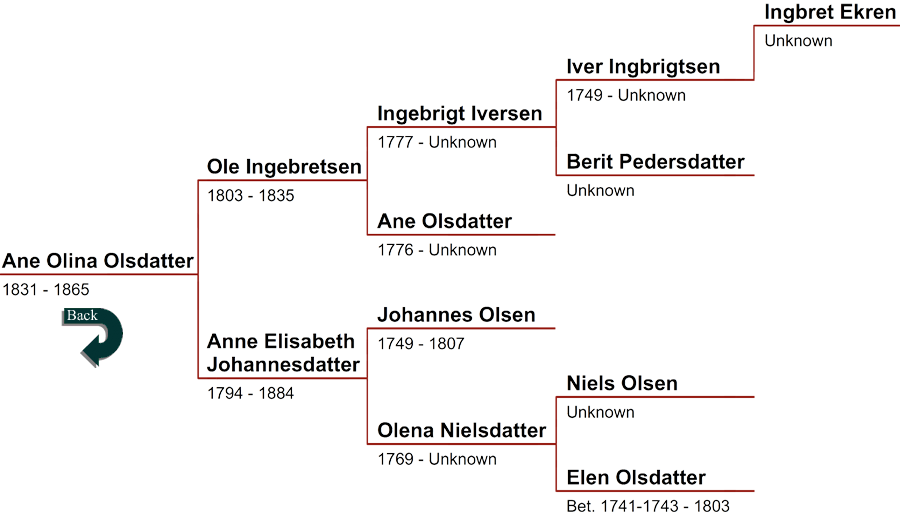 |
|
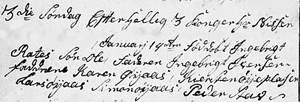 Ole Ingebretsen was born on January 14, 1803, on the Rates farm in Melhus, Sør-Trøndelag, Norway, one of three known children born to Ane Olsdatter and her husband Ingebrigt Iversen. He was baptized a week later on January 23rd in the Melhuus Parish Church. (This farm is now in the Leinstand Parish, within the municipality of Trondheim, and known as the Ratet farm.) (Mouse over and click on the baptism image right to enlarge in a new window/tab.) Six years later, in 1809, he was vaccinated by Andreas Øye in Melhus, as part of Norway’s attempt to keep the people healthy. On October 29, 1820, 17 year old Ole was confirmed at the Ørland Parish Church, while living on the Vatten farm there and working as a servant to Peder Estensen. Peder died in 1826 and three years later, in early 1829, Ole fathered a child with Peder’s widow, Anne Elisabeth Johannesdatter. Later that same year on October 8th, Ole married Anne, who was nine years older than he was, and had three young children from her first marriage. By the time of their marriage, they both were living on the Rødsten farm, which was then in Ørland, but today is in Agdenes. Over the next five years they had three children together (see Anne’s bio for details on their marriage and children). Ole Ingebretsen was born on January 14, 1803, on the Rates farm in Melhus, Sør-Trøndelag, Norway, one of three known children born to Ane Olsdatter and her husband Ingebrigt Iversen. He was baptized a week later on January 23rd in the Melhuus Parish Church. (This farm is now in the Leinstand Parish, within the municipality of Trondheim, and known as the Ratet farm.) (Mouse over and click on the baptism image right to enlarge in a new window/tab.) Six years later, in 1809, he was vaccinated by Andreas Øye in Melhus, as part of Norway’s attempt to keep the people healthy. On October 29, 1820, 17 year old Ole was confirmed at the Ørland Parish Church, while living on the Vatten farm there and working as a servant to Peder Estensen. Peder died in 1826 and three years later, in early 1829, Ole fathered a child with Peder’s widow, Anne Elisabeth Johannesdatter. Later that same year on October 8th, Ole married Anne, who was nine years older than he was, and had three young children from her first marriage. By the time of their marriage, they both were living on the Rødsten farm, which was then in Ørland, but today is in Agdenes. Over the next five years they had three children together (see Anne’s bio for details on their marriage and children).
About a year after their last child was born, 32 year-old Ole Ingebretsen died on October 1, 1835, on the Rødsten farm, leaving his wife with five children. He was buried on November 8th in the Ørland Parish Church. (Mouse over and click on burial image left to enlarge in a new window/tab.) |
| ~< Back to Chart >~ |
|
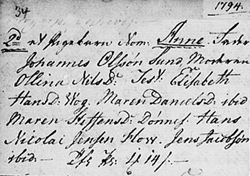 Anne Elisabeth Johannesdatter was one of six children born to Olena Nielsdatter and her husband Johannes Olsen, on the Sund farm, sometime before March 23, 1794, the date of her baptism at the Dønness Church, in the Dønna Parish, in the Nesna Prestegjeld, in Nordland County, Norway. (Mouse over and click on the baptism image right to enlarge in a new window/tab.) On the 1801 census for the Sund farm, she is listed as seven year-old Anne, the oldest child, living with her siblings, her parents, and her grandmother. Her father died when she was about 13 years-old, and somehow she went to Ørland. The next we hear of Anne, is on November 28, 1822, the date she married Peder Estensen, a fisherman at the Ørland Parish Church, in Brekstad, Sør-Trøndelag County. (Mouse over and click on marriage image below left to enlarge in a new window/tab.) Both of them were living on the Vatten farm there. Peder and Anne’s life seems to have been a good one, as they had at least one servant, ancestor Ole Ingebretsen. Some time before mid 1825, the family with servant Ole, moved to the Rødsten farm in Agdenes, also in the Ørland Parish. Anne Elisabeth Johannesdatter was one of six children born to Olena Nielsdatter and her husband Johannes Olsen, on the Sund farm, sometime before March 23, 1794, the date of her baptism at the Dønness Church, in the Dønna Parish, in the Nesna Prestegjeld, in Nordland County, Norway. (Mouse over and click on the baptism image right to enlarge in a new window/tab.) On the 1801 census for the Sund farm, she is listed as seven year-old Anne, the oldest child, living with her siblings, her parents, and her grandmother. Her father died when she was about 13 years-old, and somehow she went to Ørland. The next we hear of Anne, is on November 28, 1822, the date she married Peder Estensen, a fisherman at the Ørland Parish Church, in Brekstad, Sør-Trøndelag County. (Mouse over and click on marriage image below left to enlarge in a new window/tab.) Both of them were living on the Vatten farm there. Peder and Anne’s life seems to have been a good one, as they had at least one servant, ancestor Ole Ingebretsen. Some time before mid 1825, the family with servant Ole, moved to the Rødsten farm in Agdenes, also in the Ørland Parish.
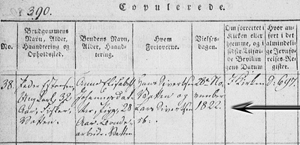 Peder and Anne had at least three children, the first two born on the Vatten farm — Karen Regine was born prior to the marriage on April 6, 1821, baptized there on May 6th, and was confirmed on October 17, 1838; son Esten was born on January 3, 1823, only two months after their marriage, was baptized on October 14th, died at 9 years-old on the Rødsten farm on September 26, 1832, and was buried at the Ørland Church a few weeks later on October 14th; and Margrethe Bergitta, who was born on the Rødsten farm on June 3, 1825, baptized on September 11th, and confirmed on October 3, 1841. On December 24, 1826, Christmas Eve, Peder froze to death, and was buried on January 8, 1827 in the Ørland churchyard. Anne was left with three young children on the Rødsten farm. Peder and Anne had at least three children, the first two born on the Vatten farm — Karen Regine was born prior to the marriage on April 6, 1821, baptized there on May 6th, and was confirmed on October 17, 1838; son Esten was born on January 3, 1823, only two months after their marriage, was baptized on October 14th, died at 9 years-old on the Rødsten farm on September 26, 1832, and was buried at the Ørland Church a few weeks later on October 14th; and Margrethe Bergitta, who was born on the Rødsten farm on June 3, 1825, baptized on September 11th, and confirmed on October 3, 1841. On December 24, 1826, Christmas Eve, Peder froze to death, and was buried on January 8, 1827 in the Ørland churchyard. Anne was left with three young children on the Rødsten farm.
 The next we know of Anne is on September 27, 1829, when she baptized her daughter, Petrine Lovise, who was fathered by her servant, ancestor Ole Ingebretsen. This is an interesting record because although they weren’t married on January 12, 1829, when the child was born, the record shows the child to be legitimate. It could be that they were engaged for a long period prior to the marriage date of October 8, 1829, and because the wedding date was set, the priest thought it best not to mention it. (Mouse over and click on marriage image right to enlarge in a new window/tab.) Ole and Anne had two other children born on the Rødsten farm — ancestor Ane Olina; and son Esten, born on June 10, 1834, baptized five days later on the 15th, married Lovise Caroline Olsdatter from Lauvøya, and died in 1913 in Nord-Trondelag county. An interesting marriage took place within this family, Petrine Lovise’s son Kristoffer married ancestor Ane Olina’s daughter Josefine, who was his first cousin. The next we know of Anne is on September 27, 1829, when she baptized her daughter, Petrine Lovise, who was fathered by her servant, ancestor Ole Ingebretsen. This is an interesting record because although they weren’t married on January 12, 1829, when the child was born, the record shows the child to be legitimate. It could be that they were engaged for a long period prior to the marriage date of October 8, 1829, and because the wedding date was set, the priest thought it best not to mention it. (Mouse over and click on marriage image right to enlarge in a new window/tab.) Ole and Anne had two other children born on the Rødsten farm — ancestor Ane Olina; and son Esten, born on June 10, 1834, baptized five days later on the 15th, married Lovise Caroline Olsdatter from Lauvøya, and died in 1913 in Nord-Trondelag county. An interesting marriage took place within this family, Petrine Lovise’s son Kristoffer married ancestor Ane Olina’s daughter Josefine, who was his first cousin.
A year after Ole and Anne’s son Esten was born, Ole died, leaving Anne on the Rødsten Farm with five young children. Stig Einar Trygstad, a deputy of the Agdenes Municipal Council, has researched this area in detail. He informs us that Anne Elisabeth had an illegitimate child named Andrea, with her deceased husband Ole’s brother, Sivert Ingebrigtsen. Andrea was born on the Rødsten farm on January 15, 1837, and baptized on June 11, 1837, in the Ørland Church. The interesting thing about it, is that the mother’s name listed on the record is Elisabeth Nielsdr, which happens to be Anne Elisabeth’s mother’s surname. Trygstad informed me that there wasn’t any Nielsdatter’s living on the Rødsten farm at this time. The only note on the record states, “Opgivet af Skoleholder Gudmund Engen,” which means that schoolmaster Gudmund Engen was the informant to the Church. Did Engen make the surname mistake, or was he trying to protect Anne? 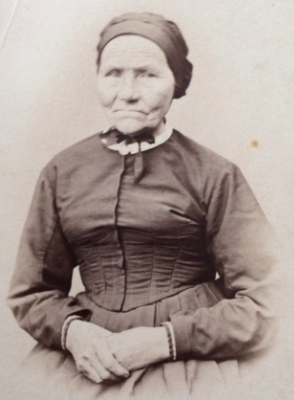 Sivert and Anne did not remain together, Sivert married someone else in 1856. Their daughter Andre was living on the Rødsten Farm when she a was confirmed on October 25, 1835, and married at the age of 25 in 1862, in the Værnes Parish Church in Agdenes. She was living on the Rishaug farm with her son and his family on the 1910 census for Agdenes. Sivert and Anne did not remain together, Sivert married someone else in 1856. Their daughter Andre was living on the Rødsten Farm when she a was confirmed on October 25, 1835, and married at the age of 25 in 1862, in the Værnes Parish Church in Agdenes. She was living on the Rishaug farm with her son and his family on the 1910 census for Agdenes.
It is not known if Anne Elisabeth married again, but on both the December 31, 1865, and December 31, 1875 census she is listed as a Kaarkone from Rødsten, who was born in the Alstahaug Prgj. i Nordland. (Alstahaug was originally the name of the parish which encompassed Dønna, where she was born.) Our Norwegian cousin has told us that “kaar is when you are old and given the farm to the next generation, a son or daughter!! Then you live in kaar!! Today you move out of the main house and into this "kaarhus", a new, not necessarily smaller but a new home on the premises!! I believe back then you just got a room or a smaller part of the house!!” Anne was living with Johan Christian Svee, who was the son of her first husband Peder’s sister Gidsken, thus her nephew. (Mouse over her photo left.) The Amazing thing is, that she was on the Wiig farm, the same farm that her grandson, ancestor Ove Kristen was on. Did she know Ove was her grandchild, or even have a relationship with him? Did she inspire him to leave Ørland and go to Nordland? We probably will never know.
 Anne Elisabeth Johannesdatter lived an interesting and long life, she outlived two husbands and at least two of her children. She died at 90 years-old, on the Vig farm, on December 28, 1884, and was buried in the Ørland churchyard on January 8, 1885. (Mouse over and click on burial image left to enlarge in a new window/tab.) Anne Elisabeth Johannesdatter lived an interesting and long life, she outlived two husbands and at least two of her children. She died at 90 years-old, on the Vig farm, on December 28, 1884, and was buried in the Ørland churchyard on January 8, 1885. (Mouse over and click on burial image left to enlarge in a new window/tab.)
|
| ~< Back to Chart >~ |
 Ingebrigt Iversen was born on the Ogstad farm in Melhus, Sør-Trøndelag County, Norway, one of eight children born to Berit Pedersdatter and Iver Ingebrigtsen. He was baptized on August 10, 1777, in the Leinstrand parish church, in the Melhus Prestegjeld. (Mouse over baptism image right and marriage image below.) By the time he was confirmed on June 30, 1793, he was living on the Ekren farm, where his father’s family was from, just west of the Ogstad farm. Seven years later he was living north of the Ekren farm, on the Stav farm, where he met Ane Olsdatter and married her on September 7, 1800. The February 1, 1801 census tells us that Ane was 25 years old, about a year older than Ingebrigt Iversen was born on the Ogstad farm in Melhus, Sør-Trøndelag County, Norway, one of eight children born to Berit Pedersdatter and Iver Ingebrigtsen. He was baptized on August 10, 1777, in the Leinstrand parish church, in the Melhus Prestegjeld. (Mouse over baptism image right and marriage image below.) By the time he was confirmed on June 30, 1793, he was living on the Ekren farm, where his father’s family was from, just west of the Ogstad farm. Seven years later he was living north of the Ekren farm, on the Stav farm, where he met Ane Olsdatter and married her on September 7, 1800. The February 1, 1801 census tells us that Ane was 25 years old, about a year older than  Ingebrigt, and born about 1776. It also states they were both in their first marriage, living on the Rathe farm in Meelhuus, and had one son. Ingebrigt’s occupation is difficult to translate, but it seems to say he was a day worker. Ingebrigt, and born about 1776. It also states they were both in their first marriage, living on the Rathe farm in Meelhuus, and had one son. Ingebrigt’s occupation is difficult to translate, but it seems to say he was a day worker. 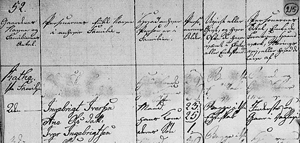 The Rathe farm is in the Melhus Parish and is just south of all the other farms he lived on, which are in the Leinstrand Parish. (Mouse over and click on census image right to enlarge in a new window/tab.) The Rathe farm is in the Melhus Parish and is just south of all the other farms he lived on, which are in the Leinstrand Parish. (Mouse over and click on census image right to enlarge in a new window/tab.)
Ingebrigt and Ane had at least four children together — Iver, who was named after Ingebrigt’s father, was born on the Stav farm, was baptized on August 24, 1801, in the Leinstrand parish church, confirmed in Ørland on November 4, 1821, married there on November 4, 1821, and died on June 6, 1866, in Agdenes; ancestor Ole; Ingebor Anna was born on October 8, 1806, in Byeaasen, baptized in the Nidaros Cathedral in Trondheim on November 2, 1806, traveled from Strinden (Byåsen) to Ørland in 1833, where she registered her immigration to Agdenæs to be a servant, married in Ørland on January 10, 1840, and died on the Selven farm in Agdenes on July 6, 1869; and son Sivert, who was baptized on October 23, 1814, in Surnadal, Møre og Romsdal County, Norway, was confirmed on October 25, 1835, while living on the Fremstad farm in Agdenes, Sør-Trøndelag County, married in Ørland on September 25, 1856, and died on April 24, 1875, on the Fremstad farm. On Sivert’s baptism record, it states that his father, Ingebrigt Ivers lived on the Echrens farm, and his mother, Anne Olsd was from Melhus. This seems to indicate that they were just visiting in Surnadal, not working there. Unfortunately, it doesn’t state the farm they were on. The names Ivers and Ingebrit seem to be common in Surnadal, so they may have been visiting family. As you can see, this family moved around a lot! It is interesting that their children went their separate ways, but they all ended up in Agdenes. We may never know what brought them there.
Unfortunately, not only is nothing known about Ane’s ancestry, but what became of Ingebrigt and Ane is a mystery also. It is assumed they returned to Melhus and lived out their lives on the Ekren farm. Death records for either of them can not be found in Sør-Trøndelag or Møre og Romsdal counties. |
| ~< Back to Chart >~ |
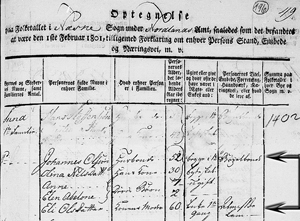 Johannes Olsen’s ancestry is unknown. He was born about 1749, possibly on the Dønnes farm in Nesna, Nordland County, Norway. On September 4, 1791, he married Olline Nielsdr in the Dønness Parish Church, and they had at least six children together (see Olena Nielsdatter’s bio below for details). By the time of the 1801 census, they all were living on the Sund farm in Nesna. (Mouse over and click on 1801 Census image right to enlarge in a new window/tab.) The Sund and Dønnes farms are not close to each other. They are separated by the Skipsfjorden. On the census, Johannes occupation was listed as Bøxelbonde, which doesn’t translate into English, but means he was a tenant farmer, he did not own the land he farmed, but rented it. This census lists his age as 52, which gives us his estimated birth year. The Local parish is listed as Næsne and Dønnæs, and the Parish is listed as Næsne, which comes under the Nesna prestegjeld. The census gives us the names of his surviving children, wife, and mother-in-law. Johannes Olsen’s ancestry is unknown. He was born about 1749, possibly on the Dønnes farm in Nesna, Nordland County, Norway. On September 4, 1791, he married Olline Nielsdr in the Dønness Parish Church, and they had at least six children together (see Olena Nielsdatter’s bio below for details). By the time of the 1801 census, they all were living on the Sund farm in Nesna. (Mouse over and click on 1801 Census image right to enlarge in a new window/tab.) The Sund and Dønnes farms are not close to each other. They are separated by the Skipsfjorden. On the census, Johannes occupation was listed as Bøxelbonde, which doesn’t translate into English, but means he was a tenant farmer, he did not own the land he farmed, but rented it. This census lists his age as 52, which gives us his estimated birth year. The Local parish is listed as Næsne and Dønnæs, and the Parish is listed as Næsne, which comes under the Nesna prestegjeld. The census gives us the names of his surviving children, wife, and mother-in-law.

Johannes Olsen died on the Sund farm and was buried in the Dønness Parish Churchyard on June 21, 1807. Unfortunately, nothing else is known about him. (Mouse over and click on burial record image left to enlarge in a new window/tab.) |
| ~<^>~ |
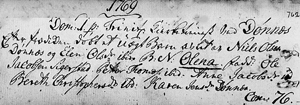 Olena Nielsdatter was born on the Dønnes farm to parents Elen Olsdatter and Niels Olsen, before May 28, 1769, the date she was baptized in the Dønness Parish Church, in Nesna, Nordland County, Norway. Both her given and surname have been spelled many different ways, including Oline, Olina, Ollina, and her surname has been recorded as Nilsdatter. We are using her name as it is recorded on her birth record. (Mouse over and click on the baptism image right to enlarge in a new window/tab.) Olena Nielsdatter was born on the Dønnes farm to parents Elen Olsdatter and Niels Olsen, before May 28, 1769, the date she was baptized in the Dønness Parish Church, in Nesna, Nordland County, Norway. Both her given and surname have been spelled many different ways, including Oline, Olina, Ollina, and her surname has been recorded as Nilsdatter. We are using her name as it is recorded on her birth record. (Mouse over and click on the baptism image right to enlarge in a new window/tab.)
The Dønnes farm has the same name as the municipality and the parish, plus it is located right across from the Dønness Parish Church, so this farm might have been an important one to the community.  Olena married Johannes Olsen there on September 4, 1791, and they had at least six children together, all but the first child, were born on the Sund farm — Ane was born before the marriage, as she was baptized on July 24, 1791, while her parents were still living on the Dønnes farm, and died no older than nine years-old, as she is not on the 1801 census, but no death record can be found for her; son Ole was born on September 20, 1792, but died and was buried three days later on the 23rd; ancestor Anne Elisabeth; another Ole was baptized on November 6, 1796, but died at age 41/2 and was buried on May 25, 1801; Elen Abelone was baptized on May 12, 1799, and is believed to be the daughter who died and was buried with her grandmother, Elen Olsdatter, on June 5, 1803; and Olina Andrina, who was baptized on May 3, 1801, but no other record, can be found for her, so she may have died young also. If this is the case, Olena buried all but one of her children. (Mouse over and click on marriage image left to enlarge in a new window/tab.) Olena married Johannes Olsen there on September 4, 1791, and they had at least six children together, all but the first child, were born on the Sund farm — Ane was born before the marriage, as she was baptized on July 24, 1791, while her parents were still living on the Dønnes farm, and died no older than nine years-old, as she is not on the 1801 census, but no death record can be found for her; son Ole was born on September 20, 1792, but died and was buried three days later on the 23rd; ancestor Anne Elisabeth; another Ole was baptized on November 6, 1796, but died at age 41/2 and was buried on May 25, 1801; Elen Abelone was baptized on May 12, 1799, and is believed to be the daughter who died and was buried with her grandmother, Elen Olsdatter, on June 5, 1803; and Olina Andrina, who was baptized on May 3, 1801, but no other record, can be found for her, so she may have died young also. If this is the case, Olena buried all but one of her children. (Mouse over and click on marriage image left to enlarge in a new window/tab.)
Unfortunately, it is not known where or when Olena Nielsdatter died, but it was after February 1, 1801, the date of the census. If she died before or soon after her husband, that may be part of why ancestor Anne Elizabeth came to be in Ørland. |
| ~< Back to Chart >~ |
Iver Ingebrigtsen was born on the Ekren farm in the Melhus Prestegjeld, of Sør-Trøndelag County, Norway, some time before he was baptized on April 7, 1749, in the Leinstrand Parish Church. He was one of five known children of Ingbret Ekren and his unnamed wife.
Iver met and became involved with Berit Pedersdatter, who may have been from the Ogstad farm in either the Melhus or Leinstrand Parish (records for these parishes are combined in one book).  Iver and Berit were engaged on October 30, 1767, and married two months later on December 28th. (Mouse over and click on marriage image right to enlarge in a new window/tab.) The marriage record lists Iver’s father’s name and an Anders Ogstad, who may have been Berit’s step father, brother, or the head of the farm she lived on. Unfortunately, nothing is known about Berit prior to her marriage. Iver and Berit settled on the Ogstad farm and had at least eight children together all born there, and baptized on the dates shown in the Leinstrand Parish — Jon was born on March 11, 1768, less than three months after the marriage, baptized on the 13th, and died at 14 days old on March 25, 1768; Arnt Christopher on October 13, 1771, was confirmed on May 4, 1788; Anders on December 5, 1773, was confirmed with his brother Arnt; another Jon on May 28, 1775, confirmed on June 30, 1793; ancestor Ingebrigt; Halvor on November 14, 1779; Simon on May 11, 1781; and Karen on April 12, 1784. It should be noted that on all of these baptism records, the father is listed as Iver Ogstad. By May 4, 1788, the family was living on the Ekren farm, where their four eldest sons were confirmed. It isn’t known why they left the Ogstad farm and moved to the Ekren farm, but it could be Iver’s father died and he went to help with the farm. Iver and Berit were engaged on October 30, 1767, and married two months later on December 28th. (Mouse over and click on marriage image right to enlarge in a new window/tab.) The marriage record lists Iver’s father’s name and an Anders Ogstad, who may have been Berit’s step father, brother, or the head of the farm she lived on. Unfortunately, nothing is known about Berit prior to her marriage. Iver and Berit settled on the Ogstad farm and had at least eight children together all born there, and baptized on the dates shown in the Leinstrand Parish — Jon was born on March 11, 1768, less than three months after the marriage, baptized on the 13th, and died at 14 days old on March 25, 1768; Arnt Christopher on October 13, 1771, was confirmed on May 4, 1788; Anders on December 5, 1773, was confirmed with his brother Arnt; another Jon on May 28, 1775, confirmed on June 30, 1793; ancestor Ingebrigt; Halvor on November 14, 1779; Simon on May 11, 1781; and Karen on April 12, 1784. It should be noted that on all of these baptism records, the father is listed as Iver Ogstad. By May 4, 1788, the family was living on the Ekren farm, where their four eldest sons were confirmed. It isn’t known why they left the Ogstad farm and moved to the Ekren farm, but it could be Iver’s father died and he went to help with the farm.
Unfortunately, a probable death record in Sør-Trøndelag County for either Iver or Berit can’t be found. It is possible they moved out of the county, but with Iver’s surname changing with the farm he lived on, it is difficult to know for sure. Berit’s name is far too common, so finding anything out about her is very difficult. |
| ~< Back to Chart >~ |
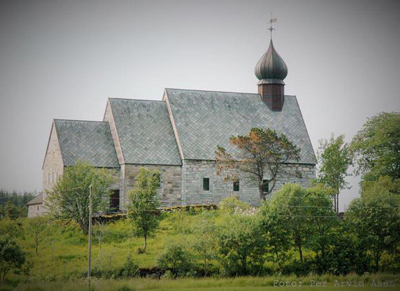 Niels Olsen and Elen Olsdatter are the parents of Olena Nielsdatter, unfortunately, not much is known about them. There is a confirmation record dated in July of 1768, for a girl with her name, living on the Dønnes farm in Nesna, Nordland County, Norway, but her age isn’t listed. According to other documentation, she would have been 25 to 27 years-old, which seems too old for a confirmation, unless she was going to be married, and was never confirmed. Unfortunately, there are 4 pages missing from the record book where their marriage should be, if this is the case. What is documented for her, is the February 1, 1801 census. Elen is listed as a 60 year-old, first time widow, living with her daughter Olena and her family on the Sund farm. This puts her birth year in about 1741. Three years later, on June 5, 1803, we find a Dønness Parish Church burial record for her name, living on the Sund farm, but still has her age as 60, which puts her birth year in 1643. (Mouse over the photo of the Dønness Parish Church for more info.) This burial record also lists an unnamed daughter of Johannes Olsen of the Sund farm. Niels Olsen died prior to his wife, but when is unknown. Niels Olsen and Elen Olsdatter are the parents of Olena Nielsdatter, unfortunately, not much is known about them. There is a confirmation record dated in July of 1768, for a girl with her name, living on the Dønnes farm in Nesna, Nordland County, Norway, but her age isn’t listed. According to other documentation, she would have been 25 to 27 years-old, which seems too old for a confirmation, unless she was going to be married, and was never confirmed. Unfortunately, there are 4 pages missing from the record book where their marriage should be, if this is the case. What is documented for her, is the February 1, 1801 census. Elen is listed as a 60 year-old, first time widow, living with her daughter Olena and her family on the Sund farm. This puts her birth year in about 1741. Three years later, on June 5, 1803, we find a Dønness Parish Church burial record for her name, living on the Sund farm, but still has her age as 60, which puts her birth year in 1643. (Mouse over the photo of the Dønness Parish Church for more info.) This burial record also lists an unnamed daughter of Johannes Olsen of the Sund farm. Niels Olsen died prior to his wife, but when is unknown.
There are about two dozen baptism records for children of a Niels Olsen, without a mother’s name, born on various farms. There is an eight year gap prior to Olena’s baptism in 1769. Could it be that Niels was married prior and some of those two dozen children are his, from a previous wife. Listing Elen on their first born child’s baptism record is a way to differentiate Neils’ new family from the old. There are only two baptism records after Olena’s that could be Neils and Elen’s children — Elen baptized on January 5, 1772; and Elen Severina, baptized on March 13, 1774. They both look as if they were in the Dønnes parish, with similar looking farm names, that are not listed as current Nordland County farms. Hopefully, some day these hard to read documents will be transcribed. Until then we can only speculate about them. |
| ~<^>~ |
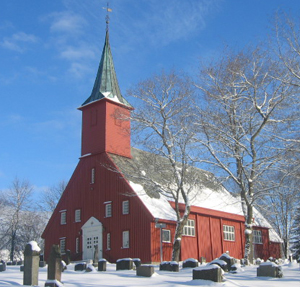 Ingbret Ekren ’s ancestry is unknown. We know nothing about his life except that he lived and worked on the Ekren farm. What we know of him comes from the baptismal records of his five children, all baptized on the dates shown while he was living on the Ekren farm in the Leinstrand Parish of Melhus, Sør-Trøndelag County, Norway — ancestor Iver; Kari on July 2, 1751; Guru on July 2, 1753; Marit on July 11, 1756; and Jon on September 10, 1758. All of these records have the father listed as either Ingbret Ekran, Ingbret Ekren, or Ingebrigt Ekren. It is assumed they were all baptized in the Leinstrand Parish Church, pictured right. (Mouse over the image of the Leinstrand Parish Church for more information.) Ingbret Ekren ’s ancestry is unknown. We know nothing about his life except that he lived and worked on the Ekren farm. What we know of him comes from the baptismal records of his five children, all baptized on the dates shown while he was living on the Ekren farm in the Leinstrand Parish of Melhus, Sør-Trøndelag County, Norway — ancestor Iver; Kari on July 2, 1751; Guru on July 2, 1753; Marit on July 11, 1756; and Jon on September 10, 1758. All of these records have the father listed as either Ingbret Ekran, Ingbret Ekren, or Ingebrigt Ekren. It is assumed they were all baptized in the Leinstrand Parish Church, pictured right. (Mouse over the image of the Leinstrand Parish Church for more information.)
 Upon researching the male only 1701 census for the Ekren farm in the Leinstrand Parish, which is the only possible census he could be on time wise, we find the farm name listed as what looks like Echren Stag. (Mouse over and click on the census image left to enlarge in a new window/tab.) Listed on it are two males aged 60 and 56, and a 10 year-old son, whose name could be Ingbret Iversen. There is also a 19 year-old worker, who seems to be unrelated, whose name is also hard to read, but doesn’t look like Ingbret at all. If the young boy is our ancestor, there is a problem, as he would have been born in 1691 making him 58 when his first child was born and 67 when the last child was born. This seems very unlikely, but he may have been born later into this family. Unfortunately, nothing more is known about Ingbret. Upon researching the male only 1701 census for the Ekren farm in the Leinstrand Parish, which is the only possible census he could be on time wise, we find the farm name listed as what looks like Echren Stag. (Mouse over and click on the census image left to enlarge in a new window/tab.) Listed on it are two males aged 60 and 56, and a 10 year-old son, whose name could be Ingbret Iversen. There is also a 19 year-old worker, who seems to be unrelated, whose name is also hard to read, but doesn’t look like Ingbret at all. If the young boy is our ancestor, there is a problem, as he would have been born in 1691 making him 58 when his first child was born and 67 when the last child was born. This seems very unlikely, but he may have been born later into this family. Unfortunately, nothing more is known about Ingbret.
|
| ~< Back to Chart >~ |
Ancestral Residences/Farms in the Trondheim, Leinstranden, and Melhus Areas
Oluf Rygh compiled a list of 70 farm names in the Leinstranden Parish and 94 in the Melhus Parish in his Norwegian Farm Names books. Many of them had different names down through the years. The map below shows their general locations and spellings as used today, as found on the Norway's Parishes website. The name variations on our ancestors farms that Rygh lists are as follows:
Leinstranden Parish
Ekren: Langecker, Eckren, and Echren.
Okstad: Oustadt, Vgstadt, Oxstad, Øgsta, Aagsta, Ogsta, and Ogstad.
Stav: Stafue, Staffwe, Staff, Stauff, Staf.
Melhus Parish
Ratet: Radte, Ratte, Raade, and Ratte. The documents found for Ole Ingebretsen and his parents Ingebrigt Iversen and Ane Olsdatter, do not use any of these spellings, instead they used Rathe and Rateś.
Trondheim
Byåsen: referred to as Byeaasen in Ingebrigt Iversen's bio, is in the Strinda clerical district, which is in the city of Trondheim. Byåsen makes up a large part of the city and encompasses a number of areas southwest of the city center. The name Byåsen can be translated into city hill, as it just under 1,000 feet above sea level, overlooking the rest of Trondheim. Because of its elevation, there is more snow in Byåsen during the winter than in lower parts of Trondheim. Ingebrigt Iversen and Ane Olsdatter lived somewhere in Byåsen in 1806.
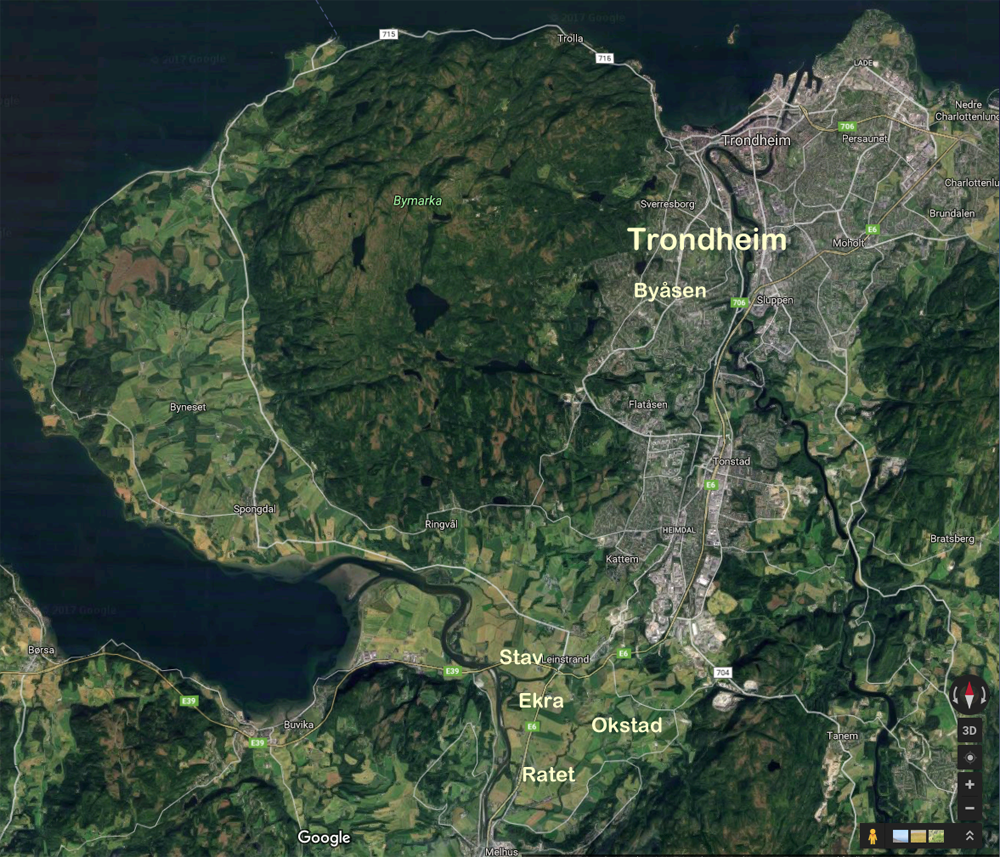
|
~< Back to Chart >~ |






 Sivert and Anne did not remain together, Sivert married someone else in 1856. Their daughter Andre was living on the Rødsten Farm when she a was confirmed on October 25, 1835, and married at the age of 25 in 1862, in the Værnes Parish Church in Agdenes. She was living on the Rishaug farm with her son and his family on the 1910 census for Agdenes.
Sivert and Anne did not remain together, Sivert married someone else in 1856. Their daughter Andre was living on the Rødsten Farm when she a was confirmed on October 25, 1835, and married at the age of 25 in 1862, in the Værnes Parish Church in Agdenes. She was living on the Rishaug farm with her son and his family on the 1910 census for Agdenes.
 Ingebrigt Iversen was born on the
Ingebrigt Iversen was born on the  Ingebrigt, and born about 1776. It also states they were both in their first marriage, living on the
Ingebrigt, and born about 1776. It also states they were both in their first marriage, living on the 





 Niels Olsen and Elen Olsdatter are the parents of Olena Nielsdatter, unfortunately, not much is known about them. There is a confirmation record dated in July of 1768, for a girl with her name, living on the Dønnes farm in Nesna, Nordland County, Norway, but her age isn’t listed. According to other documentation, she would have been 25 to 27 years-old, which seems too old for a confirmation, unless she was going to be married, and was never confirmed. Unfortunately, there are 4 pages missing from the record book where their marriage should be, if this is the case. What is documented for her, is the February 1, 1801 census. Elen is listed as a 60 year-old, first time widow, living with her daughter Olena and her family on the Sund farm. This puts her birth year in about 1741. Three years later, on June 5, 1803, we find a Dønness Parish Church burial record for her name, living on the Sund farm, but still has her age as 60, which puts her birth year in 1643. (Mouse over the photo of the Dønness Parish Church for more info.) This burial record also lists an unnamed daughter of Johannes Olsen of the Sund farm. Niels Olsen died prior to his wife, but when is unknown.
Niels Olsen and Elen Olsdatter are the parents of Olena Nielsdatter, unfortunately, not much is known about them. There is a confirmation record dated in July of 1768, for a girl with her name, living on the Dønnes farm in Nesna, Nordland County, Norway, but her age isn’t listed. According to other documentation, she would have been 25 to 27 years-old, which seems too old for a confirmation, unless she was going to be married, and was never confirmed. Unfortunately, there are 4 pages missing from the record book where their marriage should be, if this is the case. What is documented for her, is the February 1, 1801 census. Elen is listed as a 60 year-old, first time widow, living with her daughter Olena and her family on the Sund farm. This puts her birth year in about 1741. Three years later, on June 5, 1803, we find a Dønness Parish Church burial record for her name, living on the Sund farm, but still has her age as 60, which puts her birth year in 1643. (Mouse over the photo of the Dønness Parish Church for more info.) This burial record also lists an unnamed daughter of Johannes Olsen of the Sund farm. Niels Olsen died prior to his wife, but when is unknown. Ingbret Ekren ’s ancestry is unknown. We know nothing about his life except that he lived and worked on the
Ingbret Ekren ’s ancestry is unknown. We know nothing about his life except that he lived and worked on the 
